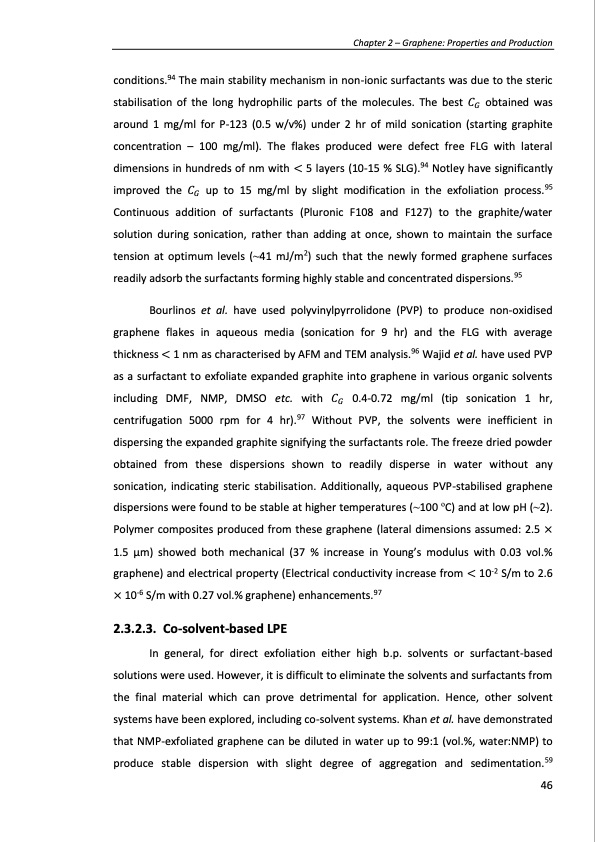
PDF Publication Title:
Text from PDF Page: 046
conditions.94 The main stability mechanism in non-ionic surfactants was due to the steric stabilisation of the long hydrophilic parts of the molecules. The best 𝐶𝐺 obtained was around 1 mg/ml for P-123 (0.5 w/v%) under 2 hr of mild sonication (starting graphite concentration – 100 mg/ml). The flakes produced were defect free FLG with lateral dimensions in hundreds of nm with < 5 layers (10-15 % SLG).94 Notley have significantly improved the 𝐶𝐺 up to 15 mg/ml by slight modification in the exfoliation process.95 Continuous addition of surfactants (Pluronic F108 and F127) to the graphite/water solution during sonication, rather than adding at once, shown to maintain the surface tension at optimum levels (~41 mJ/m2) such that the newly formed graphene surfaces readily adsorb the surfactants forming highly stable and concentrated dispersions.95 Bourlinos et al. have used polyvinylpyrrolidone (PVP) to produce non-oxidised graphene flakes in aqueous media (sonication for 9 hr) and the FLG with average thickness < 1 nm as characterised by AFM and TEM analysis.96 Wajid et al. have used PVP as a surfactant to exfoliate expanded graphite into graphene in various organic solvents including DMF, NMP, DMSO etc. with 𝐶𝐺 0.4-0.72 mg/ml (tip sonication 1 hr, centrifugation 5000 rpm for 4 hr).97 Without PVP, the solvents were inefficient in dispersing the expanded graphite signifying the surfactants role. The freeze dried powder obtained from these dispersions shown to readily disperse in water without any sonication, indicating steric stabilisation. Additionally, aqueous PVP-stabilised graphene dispersions were found to be stable at higher temperatures (~100 oC) and at low pH (~2). Polymer composites produced from these graphene (lateral dimensions assumed: 2.5 × 1.5 μm) showed both mechanical (37 % increase in Young’s modulus with 0.03 vol.% graphene) and electrical property (Electrical conductivity increase from < 10-2 S/m to 2.6 × 10-6 S/m with 0.27 vol.% graphene) enhancements.97 2.3.2.3. Co-solvent-based LPE In general, for direct exfoliation either high b.p. solvents or surfactant-based solutions were used. However, it is difficult to eliminate the solvents and surfactants from the final material which can prove detrimental for application. Hence, other solvent systems have been explored, including co-solvent systems. Khan et al. have demonstrated that NMP-exfoliated graphene can be diluted in water up to 99:1 (vol.%, water:NMP) to produce stable dispersion with slight degree of aggregation and sedimentation.59 Chapter 2 – Graphene: Properties and Production 46PDF Image | PRODUCTION AND APPLICATIONS OF GRAPHENE AND ITS COMPOSITES

PDF Search Title:
PRODUCTION AND APPLICATIONS OF GRAPHENE AND ITS COMPOSITESOriginal File Name Searched:
graphene-production-applications.PDFDIY PDF Search: Google It | Yahoo | Bing
Salgenx Redox Flow Battery Technology: Power up your energy storage game with Salgenx Salt Water Battery. With its advanced technology, the flow battery provides reliable, scalable, and sustainable energy storage for utility-scale projects. Upgrade to a Salgenx flow battery today and take control of your energy future.
| CONTACT TEL: 608-238-6001 Email: greg@infinityturbine.com | RSS | AMP |